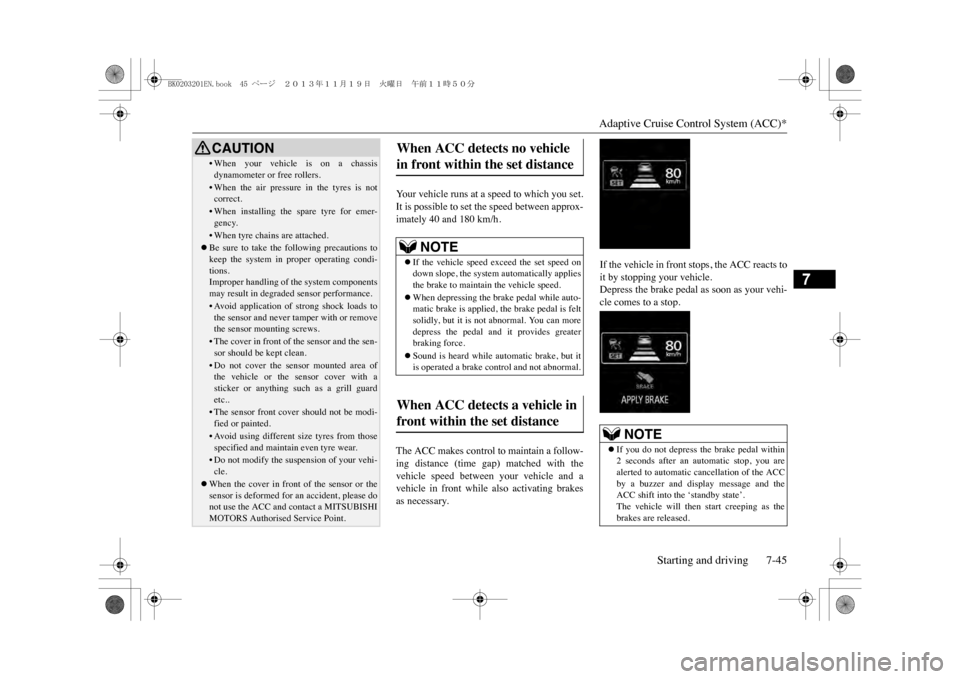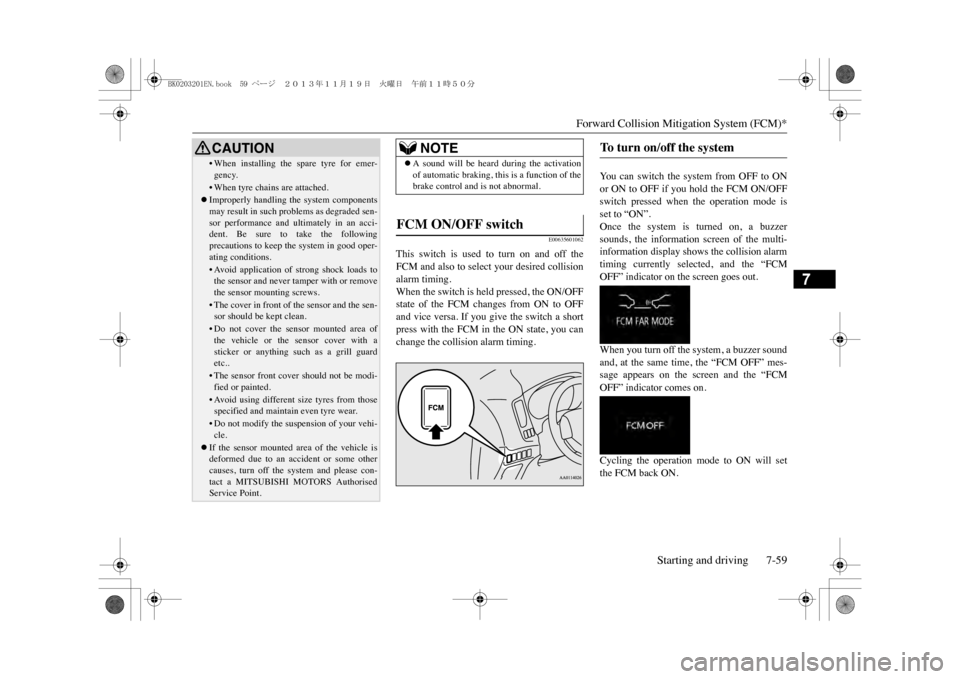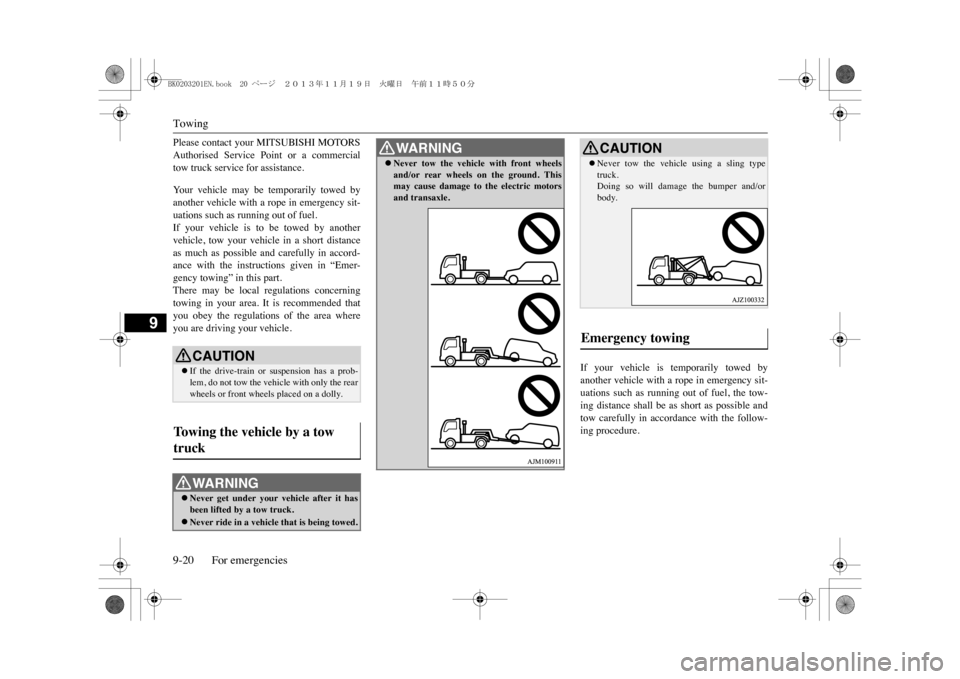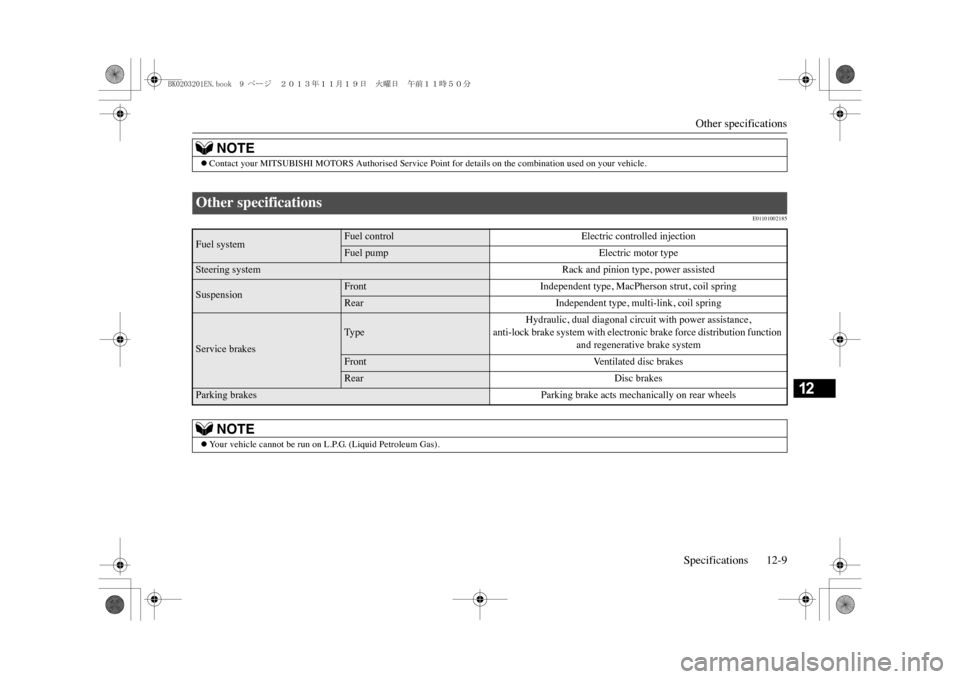2014 MITSUBISHI OUTLANDER SPORT suspension
[x] Cancel search: suspensionPage 208 of 388

Adaptive Cruise Control System (ACC)*
Starting and driving 7-45
7
Yo u r v e h i c l e r u n s a t a s p e e d t o w h i c h y o u s e t .It is possible to set the speed between approx-imately 40 and 180 km/h.The ACC makes control to maintain a follow-ing distance (time gap) matched with thevehicle speed between your vehicle and avehicle in front while also activating brakesas necessary.
If the vehicle in front stops, the ACC reacts toit by stopping your vehicle.Depress the brake pedal as soon as your vehi-cle comes to a stop.
•When your vehicle is on a chassisdynamometer or free rollers.•When the air pressure in the tyres is notcorrect.•When installing the spare tyre for emer-gency.•When tyre chains are attached.�zBe sure to take the following precautions tokeep the system in proper operating condi-tions.Improper handling of the system componentsmay result in degraded sensor performance.•Avoid application of
strong shock loads to
the sensor and never tamper with or removethe sensor mounting screws.• The cover in front of the sensor and the sen-sor should be kept clean.•Do not cover the sensor mounted area ofthe vehicle or the sensor cover with asticker or anything such as a grill guardetc..•The sensor front cove
r should not be modi-
fied or painted.•Avoid using different
size tyres from those
specified and maintain even tyre wear.•Do not modify the suspension of your vehi-cle.
�zWhen the cover in front of the sensor or thesensor is deformed for an accident, please donot use the ACC and
contact a MITSUBISHI
MOTORS Authorised Service Point.CAUTION
When ACC detects no vehicle in front within the set distance
NOTE
�zIf the vehicle speed exceed the set speed ondown slope, the system automatically appliesthe brake to maintain the vehicle speed.�zWhen depressing the brake pedal while auto-matic brake is applied, the brake pedal is feltsolidly, but it is not abnormal. You can moredepress the pedal and it provides greaterbraking force.�zSound is heard while automatic brake, but itis operated a brake control and not abnormal.
When ACC detects a vehicle in front within the set distance
NOTE
�zIf you do not depress the brake pedal within2 seconds after an automatic stop, you arealerted to automatic cancellation of the ACCby a buzzer and display message and theACC shift into the ‘standby state’.The vehicle will then start creeping as thebrakes are released.
BK0203201EN.book 45 ページ 2013年11月19日 火曜日 午前11時50分
Page 222 of 388

Forward Collision Mitigation System (FCM)*
Starting and driving 7-59
7
E00635601062
This switch is used to turn on and off theFCM and also to select your desired collisionalarm timing.When the switch is held pressed, the ON/OFFstate of the FCM changes from ON to OFFand vice versa. If you give the switch a shortpress with the FCM in the ON state, you canchange the collision alarm timing.
Yo u c a n s w i t c h t h e s y s t e m f r o m O F F t o O Nor ON to OFF if you hold the FCM ON/OFFswitch pressed when the operation mode isset to “ON”.Once the system is turned on, a buzzersounds, the information screen of the multi-information display shows the collision alarmtiming currently selected, and the “FCMOFF” indicator on the screen goes out.When you turn off the system, a buzzer soundand, at the same time, the “FCM OFF” mes-sage appears on the screen and the “FCMOFF” indicator comes on.Cycling the operation mode to ON will setthe FCM back ON.
•When installing the spare tyre for emer-gency.•When tyre chains are attached.�zImproperly handling the system componentsmay result in such problems as degraded sen-sor performance and ultimately in an acci-dent. Be sure to take the followingprecautions to keep the system in good oper-ating conditions.•Avoid application of
strong shock loads to
the sensor and never tamper with or removethe sensor mounting screws.• The cover in front of the sensor and the sen-sor should be kept clean.•Do not cover the sensor mounted area ofthe vehicle or the sensor cover with asticker or anything such as a grill guardetc..•The sensor front cove
r should not be modi-
fied or painted.•Avoid using different
size tyres from those
specified and maintain even tyre wear.•Do not modify the suspension of your vehi-cle.
�zIf the sensor mounted area of the vehicle isdeformed due to an acci
dent or some other
causes, turn off the system and please con-tact a MITSUBISHI MOTORS AuthorisedService Point.CAUTION
NOTE
�zA sound will be heard during the activationof automatic braking, this is a function of thebrake control and is not abnormal.
FCM ON/OFF switch
To t u r n o n / o f f t h e s y s t e m
BK0203201EN.book 59 ページ 2013年11月19日 火曜日 午前11時50分
Page 226 of 388

Reversing sensor system*
Starting and driving 7-63
7
E00615500374
This system operates when you are backingthe vehicle. It uses corner and back sensors todetect an obstacle and the information screenin the multi information display and thebuzzer to inform you of the approximate dis-tance to the obstacle.
E00615601473
The detection areas of the corner and backsensors are limited to those shown in theillustration. Moreover, the sensors are unableto detect low or thin objects or objects nearthe rear bumper. Thus, make sure to check thesurroundings as you operate the vehicle in asafe manner.There are two corner sensors (A) at the cor-ners of the rear bumper, and two back sensors(B) in the centre of the rear bumper.
•When passing a road section where thenumber of lanes increases/decreases ormultiple lanes are crossing each other.•When the lane is marked by double or oth-erwise special lines.•When driving on a winding or rough road.•When driving on a sli
ppery road covered by
rain water, snow, ice, etc.•When passing through a place where thebrightness suddenly ch
anges, like the inlet
or outlet of a tunnel.•When turning steep curves.•When the road surface is reflecting the lightshining from the direction opposite to therunning direction.•Vehicle largely lurches when it is runningover steps or other irregularities of the roadsurface.•When the headlamp illumination is inade-quate because of contaminated or deterio-rated lenses or improperly aimedheadlamps.•When the vehicle is leaning much to oneside due to heavy l
uggage on it or improp-
erly adjusted tyre pressures.•When oncoming vehicl
es’ headlamps shine
the LDW camera.•When the vehicle is equipped with non-standard tyres (incl
uding excessively worn
tyres), uses snow tr
action device (tyre
chains), or has non-specified componentssuch as a modified suspension.CAUTION
•When the windscreen is covered with rainwater, snow, dust, etc.
�zFollow the instructions given below to keepyour LDW in good operating conditions. •Always keep the windscreen clean.•Avoid applying a str
ong shock or pressure
to the LDW camera. Do not attempt to dis-assemble it.•Disturbing the installation of the LDWcamera or its removal is under no circum-stances permitted. The camera has beenprecisely oriented at the factory.• Do not put anything like a sticker on thearea in front of the LDW camera lens of thewindscreen.•Use only MITSUBISHI MOTORS GENU-INE Parts when replacing the windscreenwipers.
Reversing sensor system
*
CAUTION
CAUTION�zThe reversing sensor system assists you indetermining the approximate distancebetween the vehicle and an obstacle locatedbehind the vehicle. It has limitations in termsof detectable areas and objects, and may notproperly detect some objects. Therefore, donot place excessive confidence in the revers-ing sensor system, and operate the vehicle ascarefully as you would
a vehicle without this
system.�zMake sure to check the surroundings withyour own eyes to ensure safety. Do not oper-ate the vehicle by relying on the reversingsensor system alone.
Obstacle detection areas
Corner and back sensor locations
BK0203201EN.book 63 ページ 2013年11月19日 火曜日 午前11時50分
Page 331 of 388

Towing9-20 For emergencies
9
Please contact your MITSUBISHI MOTORSAuthorised Service Point or a commercialtow truck service for assistance.Yo u r v e h i c l e m a y b e t e m p o r a r i l y t o w e d b yanother vehicle with a rope in emergency sit-uations such as running out of fuel.If your vehicle is to be towed by anothervehicle, tow your vehicle in a short distanceas much as possible and carefully in accord-ance with the instructions given in “Emer-gency towing” in this part.There may be local regulations concerningtowing in your area. It is recommended thatyou obey the regulations of the area whereyou are driving your vehicle.
If your vehicle is temporarily towed byanother vehicle with a rope in emergency sit-uations such as running out of fuel, the tow-ing distance shall be as short as possible andtow carefully in accordance with the follow-ing procedure.
CAUTION�zIf the drive-train or suspension has a prob-lem, do not tow the vehicle with only the rearwheels or front wheels placed on a dolly.
To w i n g t h e v e h i c l e b y a t o w truck
WA R N I N G�zNever get under your vehicle after it hasbeen lifted by a tow truck.�zNever ride in a vehicle that is being towed.
�zNever tow the vehicle with front wheelsand/or rear wheels on the ground. Thismay cause damage to the electric motorsand transaxle.WA R N I N G
CAUTION�zNever tow the vehicl
e using a sling type
truck.Doing so will damage the bumper and/orbody.
Emergency towing
BK0203201EN.book 20 ページ 2013年11月19日 火曜日 午前11時50分
Page 378 of 388

Other specifications
Specifications 12-9
12
E01101002185
NOTE
�zContact your MITSUBISHI MOTORS Aut
horised Service Point for details on
the combination used on your vehicle.
Other specifications Fuel system
Fuel control
Electric controlled injection
Fuel pump
Electric motor type
Steering system
Rack and pinion type, power assisted
Suspension
Front
Independent type, MacPherson strut, coil spring
Rear
Independent type, multi-link, coil spring
Service brakes
Ty p e
Hydraulic, dual diagonal circuit with power assistance,
anti-lock brake system with electronic brake force distribution function
and regenerative brake system
Front
Ve n t i l a t e d d i s c b r a k e s
Rear
Disc brakes
Parking brakes
Parking brake acts mechanically on rear wheels
NOTE
�zYo u r v e h i c l e c a n n o t b e r u n o n L .
P. G. ( L i q u i d P e t r o l e u m G a s ) .
BK0203201EN.book 9 ページ 2013年11月19日 火曜日 午前11時50分